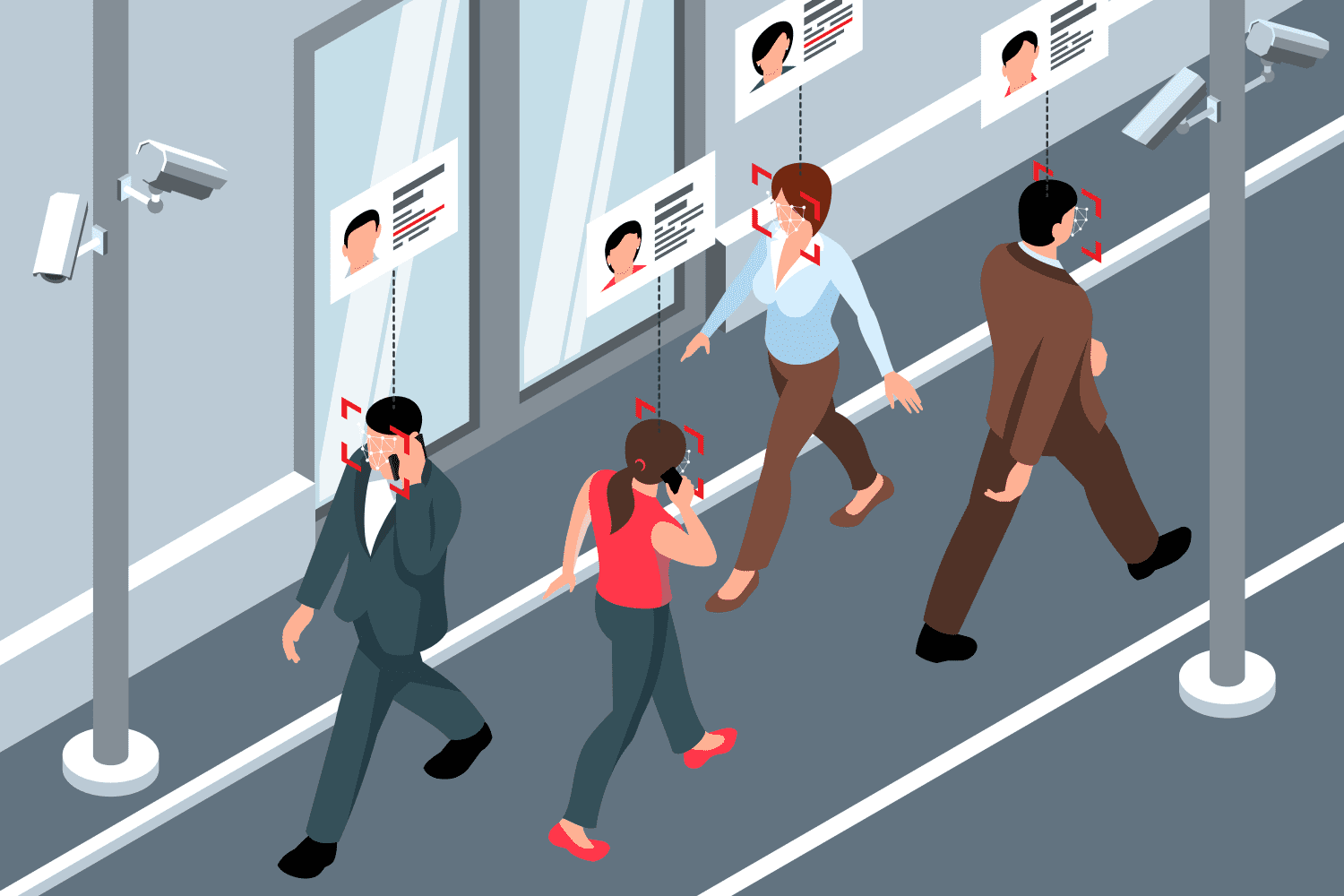
adminApril 27, 2023Uncategorized
Public safety is a key concern, and monitoring is essential to ensuring it. Traditional monitoring techniques may not be sufficient for the growing number of public spaces, including parks, streets, airports, and shopping centers – which are susceptible to a range of security risks, from theft and vandalism to terrorism and mass shootings. Effective surveillance systems that can identify and react to possible threats in real-time must be implemented by law enforcement agencies, security firms, and facility managers in order to protect public safety. Face detection technology can be a valuable tool for securing public areas in this situation.
By making it possible to automatically identify and track people based on their facial traits, face detection technology is an effective tool for securing public areas. The advantages of face detection for surveillance in public places will be discussed in this blog, along with how no-code AI platforms like DeepLobe can make it easier to use and more effective.
What is Face Detection?
Face detection is a computer vision technique that involves detecting and locating human faces in images or video frames. It operates by examining the visual patterns of the image or video and locating areas with characteristics that resemble human faces in terms of geometry and color. Once a face has been found, it can be localized by enclosing it in a bounding box and extracting its shape, texture, color. The algorithms used by the technology analyze images and identify patterns that match human facial features. These algorithms then mark the location of each face and can even estimate attributes such as age, gender, and emotion.
Face detection is a crucial component in many facial recognition and biometric identification applications and systems, as it enables the initial matching of a face to a database of known faces or identities. In real-time applications like security and surveillance, it can also be utilized as a stand-alone method for detecting faces.
Applications of Face Detection Technology in Public Spaces
In transportation hubs like airports and train stations, face detection technology can be especially helpful for enhancing public safety. These areas often become overcrowded and have a lot of foot traffic, which makes it difficult to watch for and identify any security risks.
At these transport hubs, face detection technology can be incorporated into surveillance systems to automatically identify and follow people who might be a security risk. Face detection technology, for instance, can rapidly identify someone who is on a watchlist and inform security staff if they are a known terrorist or criminal. This can keep the public safe and lessen the need for manual monitoring by preventing potential accidents before they happen.
Face detection technology has many applications, apart from threat detection, in public spaces, including:
Crowd Management
Face detection can also assist with crowd control by counting people, following their movements, and spotting crowded regions in public settings. In order to optimize traffic flow, reduce stampedes, and minimize crowding, this technology can be helpful.
Access Control
By comparing the faces of permitted staff to a database of authorized people, face detection can be used to restrict access to facilities or regions that are prohibited. Sensitive facilities, like airports, government buildings, or research labs, may benefit from increased security and privacy as a result.
Crime Prevention
By recognizing the faces of possible offenders and informing security personnel, face detection can help in the prevention of crimes like theft or vandalism. It can help in the investigation of crimes by offering visual evidence of the suspects and their movements.
Investigation Support
Investigations might benefit from face detection by locating suspects or witnesses. Face identification technology can assist in the investigation by analyzing photos or videos taken at the site of a crime to help reduce the number of potential suspects.
In addition to the applications mentioned above, face detection technology can help in contact tracing efforts during disease outbreaks. By tracking the movement of individuals in public spaces, it is possible to identify those who may have come into contact with a confirmed case of a contagious disease, such as COVID-19. This can help public health officials quickly and effectively contain outbreaks, potentially saving lives.
Face detection technology in public places, however, also poses privacy and civil liberties concerns. It is crucial to make sure that the gathering, storing, and use of facial data is done in a way that respects people’s right to privacy and is ethical and transparent. Additionally, it’s important to take into account any potential biases in technology that can disproportionately affect particular groups, such as people of color or those with disabilities.
Some countries have created regulations and guidelines for the use of facial detection technologies in public settings in order to allay these worries. For instance, the General Data Protection Regulation (GDPR) of the European Union establishes stringent guidelines for the acquisition and use of personal data, including face data. Additionally, some countries have put limitations on the use of face data for non-law enforcement reasons and regulations for the public disclosure of surveillance systems, and restrictions on the use of facial data for non-law enforcement purposes.
No-Code AI Platforms for Face Detection Technology
No-code Platforms for artificial intelligence (AI) are software tools that let non-programmers build AI models. These platforms are designed to be user-friendly, enabling anyone to create and deploy AI models for various tasks, including face detection. One such platform is DeepLobe, a no-code AI platform for computer vision tasks.
DeepLobe offers a wide range of pre-built models including face detection, making it easy for users to create models without any coding knowledge. The platform also offers an in-built and powerful data annotation tool, enabling users to optimize their models for their specific needs.
Benefits of Using No-Code AI Platforms for Face Detection
Using a no-code AI platform like DeepLobe for face detection has several benefits, including:
- Easy to use: Anyone can easily build models because no coding experience is necessary.
- Time-saving: No-code platforms offer pre-built models that can be customized to match unique requirements., saving time and effort.
- Cost-effective: No-code platforms are less expensive to use than conventional AI development techniques since they use fewer resources and take less time to develop.
Scalable: No-code platforms are flexible and scalable solutions since they can simply adapt to meet the requirements of growing enterprises.
The use of face detection technologies can help to secure public areas and ensure everyone’s safety. Face detection helps identify potential security concerns, manage crowds, limit access, and prevent or solve crimes by enabling the automatic identification and tracking of people based on their facial traits. It can be improved for public space surveillance by using no-code AI platforms like DeepLobe, which offer customizability, real-time performance, accessibility, and cost-effectiveness. DeepLobe provides a reliable, affordable, and scalable solution for face identification applications in public areas with its pre-built models and powerful tools.
If you’re interested in learning more about how DeepLobe can help with face detection in public spaces, contact us to schedule a demo.
Frequently Asked Questions (FAQs)
How can businesses and organizations integrate no-code AI for surveillance into their existing systems?
No-code AI for surveillance can be easily integrated into existing systems using APIs or software development kits (SDKs). Many AI-powered surveillance tools come with pre-built integrations for popular platforms like AWS, Google Cloud, and Azure. This makes it easier for businesses and organizations to implement no-code AI surveillance into their existing systems with minimal disruption.
How can the privacy of individuals be protected when using face detection technology for surveillance?
Clear policies and guidelines must be in place for the collection, storage, and use of data in order to preserve individual privacy when face detection technology is used for surveillance. Techniques for anonymization can also be applied to prevent the exposure of personal data. Finally, companies and organizations need to be open about how they utilize face recognition software and let people know when they are being watched.
What are some examples of face detection and no-code AI being used in public safety?
- Law enforcement organizations employ facial recognition technology to identify people on watchlists.
- No-code AI is used to identify potential security concerns by analyzing patterns in data acquired from surveillance cameras.
- Real-time tracking of suspects' movements using face detection
